- Wildhaven Permaculture Design
Main menu:
Wildhaven Farm -

This project started in 2016 when I located a property to move my animals and garden to when the property in Dallas was sold. I ended up staying at the Dallas property when the new owners offered to let me stay. However, I decided to move the sheep and some chickens up to Pritchard as I was unsure at that time how things would work out and I wanted a back up! 3yrs later I now manage both projects with the dairy goat herd and some chickens and the majority of my vegetable crops in Dallas. The sheep, more chickens, ducks and one year a couple of pigs all live in Pritchard and that farm has been slowly developing as I have the time and resources.
It is interesting working in both places at the same time as the challenges and strengths are quite different! Even the climate difference is significant with Pritchard being classified as a humid climate where as just down the mountain and a few minutes west we are in a semi -
The main systems we are working on at the Pritchard farm are developing livestock grazing cells in a silvoculture setting and planting large areas of food forest with a strong emphasis on livestock feed production. At this time we still supplement heavily with hay and grain (and water!) from off farm. Each year we get a little more feed from the land. The biggest challenge is the lack of water. The longterm plan is to put in several ponds and swales to capture the significant amount of spring runoff that currently just flows through the northern part of the property. We plan to capture much of this and store it for use as irrigation during dryer times. This is a large project that will involve machinery (or MANY hands?!) and funds that are not currently available so we are learning just how much we can do using water saving techniques such as soil improvement and heavy mulch instead! We have developed a section near the barn into garden beds and are currently using the area to grow some experimental crops and crops that we hope to adapt to drier conditions. We plan to get some water catchment systems in place on the coop, barn and shelter roofs in 2019.
We currently have two permanent sheep paddocks with shelters, a large chicken coop, a pallet barn with a couple lambing stalls and a feedroom and a small mobile chicken tractor. Plans for this summer include a duck house for our trio of eldery muscovies! A greenhouse with an attached shelter, pen and grass paddock for our ram, an additional, larger chicken tractor and the addition of some rabbit housing within the coop. We are hoping to start work on fencing for a second grazing paddock in the silvopasture area as well.
The projects here are ultra low budget! It would certainly be faster to invest a bit of money into some fencing and infratructure but that isnt an option so we work with slow and steady!
Sheep
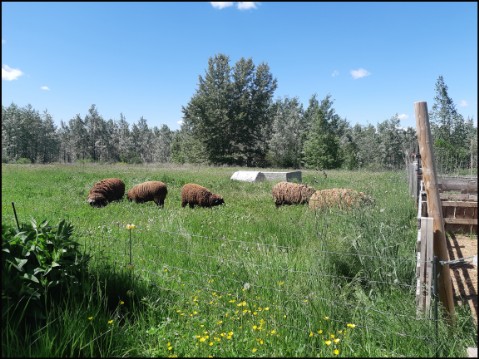
Our small flock of romeldale(CVM) sheep are the main workforce at this farm! We chose this breed for their amazing, fine wool that comes in a variety of colours but they also raise fantastic meat lambs. The ewes are prolific, nearly always having twins and occasionally triplets, and great moms. At the moment our entire flock is black but I know there are moorit genes in a couple of the ewes and we did have a white lamb this year so hopefully we will see some more colour next year!
Chickens
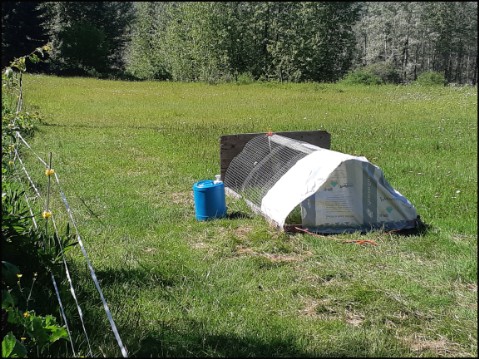
Chickens also feature prominently as farm workers. We have a very large coop that we deep bed with fall leaves throughout the winter. It composts and provides heat to the coop all winter as well as nice deep bedding for the birds to scratch around in. In the spring this mulch is used as a wonderful amendment for the gardens and pastures. In the growing season we move several of the birds out to work in the pasture in a small mobile tractor. This year we will be building an additional, larger tractor for the flat pasture that will accomodate 5-
Ducks
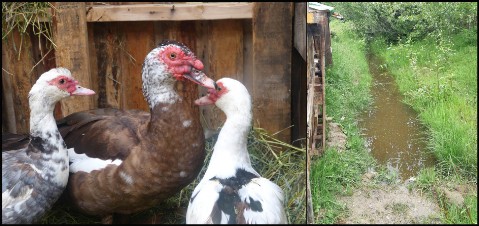
Hershey and his mates, Truffle and Oreo, are our trio of muscovie ducks. They are not the most useful members of our team at the moment but they are fun and despite their advancing age, the girls still manage to give us a regular supply of duck eggs for a few months in the summer. They have been unsuccessful in raising babies for us but that is due to a series of unfortunate events each time they try! This summer I am planning to be pro active and have a plan to help them! Maybe we will see some ducklings this year . . .
One of our big projects in 2019 is to build this family their own pen around the small pond behind the barn. This pond does dry up for much of the summer but is quick to fill after every rainfall so it will be better than the buckets of water they currently have!
Annual Garden
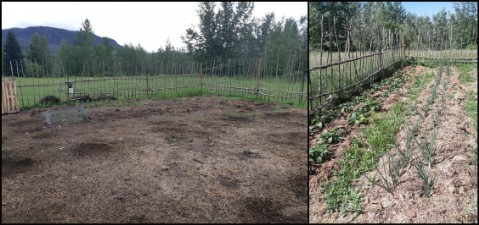
At this time we have no water source at this property other than what falls from the sky or runs across the land during spring melt. We will be working towards getting proper roofs on the barn with water collection into barrels but for now we are using the garden area to grow experimental crops and working with what we have to try and adapt some seed to drier growing conditions. In 2018 we got a fabulous crop of winter radishes -
Food Forests
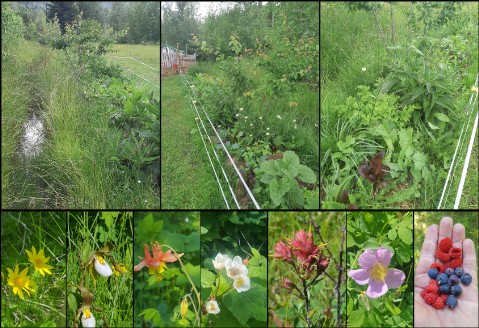
Plans for this farm include large areas of food forest with a heavy focus on livestock feed production. We are currently working on a section along the eastern edge of the main pasture where a drainage swale was already in place. This swale fills up and holds water until late spring/early summer. Heavy rainfalls will fill it up again during July and August when it will soak water into the ground for a few days until it dries up again.
This forest is planted with several apricot and plum seedling trees with plans to graft different varieties onto them once they have become established. We plan to add some apples as well. There is also mountain ash, hazelnut, elderberry and honey locust. Shrub layer is jostaberry, blackcap raspberry and we will be adding red raspberry and red current this year. Understory is a mix of comfry, herbs, sunchoke, garlic, strawberry and a groundcover of mixed greens and radish. In addition to the cultivated varieties, we are encouraging numerous native species to flourish including saskatoon, wild raspberry, thimbleberry, oregon grape and many different and beautiful wildflowers.
Silvopasture
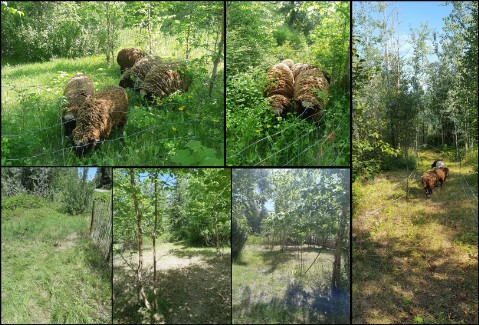
We have been slowly clearing out some of the shrubby snowberry and aspen saplings to create a more open area for pasture grasses and forbes to grow. Our design plan is for a series of grazing cells, accessed from a central laneway and with sections of food forest planted along contour swales in between the cells. These cells will accomodate our small flock for 3-